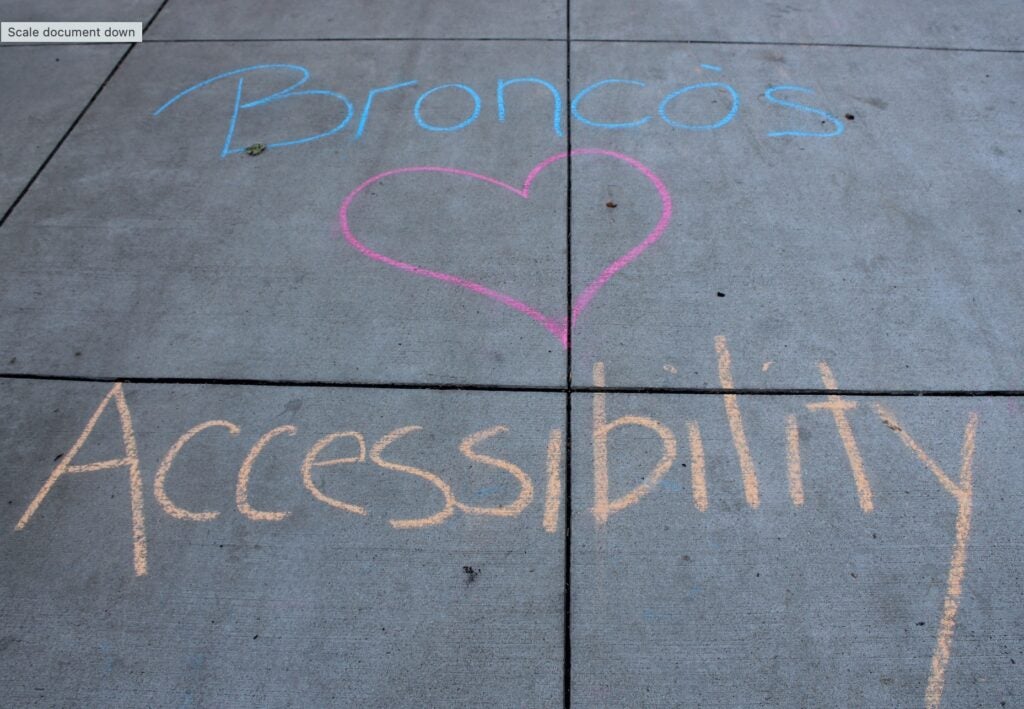
What are the Web Content Accessibility Guidelines? The Web Content Accessibility Guidelines, or WCAG, are a set of measurable standards you can follow to make your content accessible to the widest possible audience. The Guidelines are divided into three levels of compliance: A, AA, and AAA. Since most organizations aim for AA compliance, that’s where we’ll focus for this course. By following the WCAG, you can ensure everyone can use your digital content regardless of ability.
These standards are organized into four main principles:
- Perceivable
- Operable
- Understandable
- Robust
Many of these standards are added by software developers directly to the platforms and tools used to create content. Other standards are added to the content directly by you, the content creator. Even though you might not interact with all the standards, it’s good to be aware of them and understand how they work together.
Perceivable
The first principle in the Web Content Accessibility Guidelines (WCAG) is Perceivable. Content must be presented to users in ways they can perceive, often using one or more of their senses including sight, sound, and touch.
Examples of Perceivable Content
For example, a user can perceive an image with their sense of sight, or they can perceive an image through the image description with their sense of hearing. A user can perceive a video with their sense of sight and sound, or with sense of touch by accessing a text transcript through a refreshable Braille display. Other characteristics of perceivable content include the following:
- Alternatives for non-text content, such as alt text descriptions for images or long descriptions for complex objects
- Alternatives for time-based media, like captions, audio description, or text transcripts
- Content can be presented in different ways without losing information or structure, such as perceiving content in a table in a linear fashion
- Easy to distinguish foreground and background elements (colors and sounds), this includes good color contrast ratios and background sounds in videos
Content Creator Role in Perceivable Content
As a content creator, your role in creating perceivable content includes:
- Adding short, meaningful alternative text descriptions to any images, charts, or graphs uploaded to your webpage
- Adding long text descriptions of complex graphics either on the same page or as a link to an additional resource
- Describing important visual information conveyed in a media file in the audio track
- Providing accurate captions of any relevant sounds or dialogue in a media file
- Providing a text transcript of a media file that includes both relevant visual and audio information
- Using tables to present tabular data, and not merging cells, rows, or columns to convey visual information
- Ensuring the color contrast of content, particularly text, is readable
- Adding accurate labels to form fields
- Adding structure tags, like headings, to content to convey the same information presented visually
Operable
The second principle in the Web Content Accessibility Guidelines (WCAG) is Operable. Content must have an operable user interface and navigation to assist users in using and navigating content.
Examples of Operable Content
For example, a user can operate a webpage using touch to swipe the screen or they can navigate using a keyboard. A user can utilize a mouse or a screen reader to navigate content. Other characteristics of operable content include the following:
- Make all functionality available from a keyboard
- Give users enough time to read and use content
- Do not use content that causes seizures or physical reactions
- Help users navigate and find content
- Make it easier to use inputs other than a keyboard
Content Creator Role in Operable Content
As a content creator, your role in creating operable content includes:
- Review interactive elements, like forms and embedded iFrames, added to the page for keyboard compatibility
- Avoid time limits on forms or other content that might make users feel rushed
- Avoid content that moves rapidly and flashes, strobes, or blinks
- Provide clear paths to navigate the content on the page and on the site overall
Understandable
The third principle in the Web Content Accessibility Guidelines (WCAG) is Understandable. Both the information contained in and the operation of the user interface must be understandable for users.
Examples of Understandable Content
Understandable content is easy to use and take action on. For example, users can easily understand where they are on the page whether they are navigating with a keyboard, or other assistive technology. Other characteristics of understandable content include the following:
- Text is readable and understandable
- Content appears and operates in predictable ways
- Help users avoid and correct mistakes
Content Creator Role in Understandable Content
As a content creator, your role in creating understandable content includes:
- Setting the language of a webpage, or indicating where there is a change in language
- Creating a consistent navigation experience
- Structuring lists, tables, and headings correctly
- Adding labels to all form fields
- Clearly marking required form field content as required
- Providing clear instructions for completing processes
Robust
The fourth principle in the Web Content Accessibility Guidelines (WCAG) is Robust. Content must be robust enough that it can be interpreted by a wide variety of devices, browsers, and assistive technologies.
Examples of Robust Content
Robust content is compatible with the widest variety of devices, browsers, and assistive technologies. For example, users can access your content in a browser or on a mobile device. They can use text to speech tools to listen to your content or they can view your content at different levels of magnification. This means your content is maximizing compatibility with current and future user tools.
Content Creator Role in Robust Content
As a content creator, your role in creating robust content includes:
- Reviewing id attributes (or the names given to elements on a page) are unique
- Reviewing content provided in alternative formats (like documents or media) are compatible with assistive technology
| Perceivable | Operable | Understandable | Robust | |
|---|---|---|---|---|
| Definition | The content must be available to users via sight, hearing, and/or touch. | The product must be accessible, navigable, and compatible with different input methods. | The content must be readable and predictable, with clear labels and instructions. | The product must work with a variety of assistive technologies, browsers, and devices. |
| Examples | Alt text descriptions, captions, audio descriptions. | All functionality from a keyboard. | Text is readable, content appears in predictable ways. | Can access content in a browser or mobile device. |
